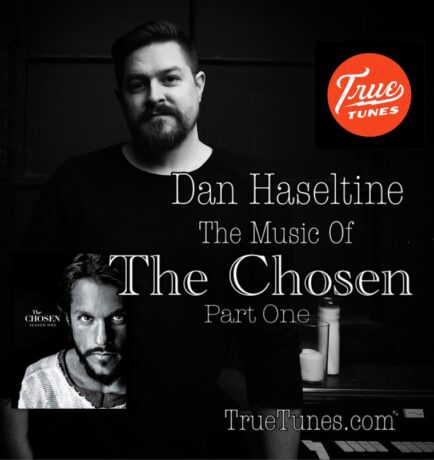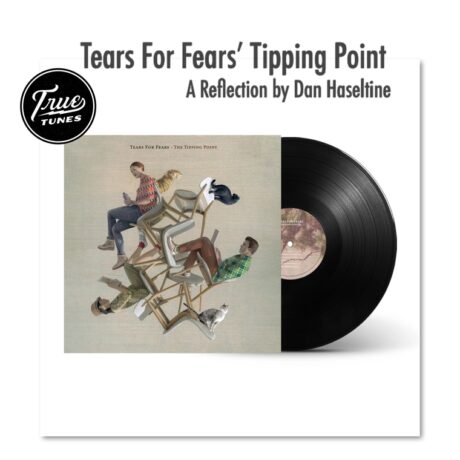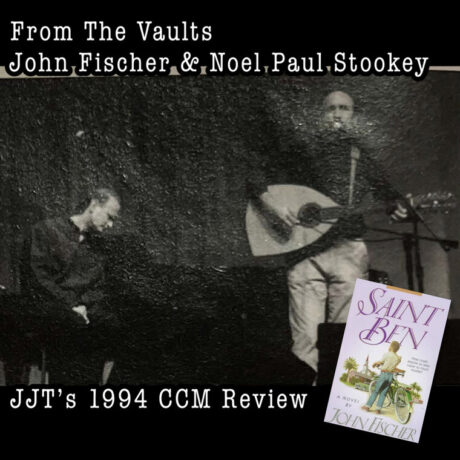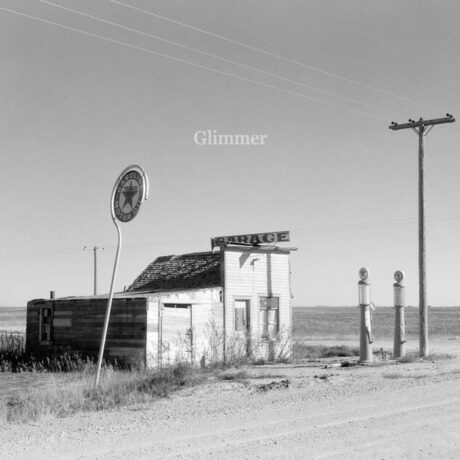Tears for Fears’ Tipping Point (a reflection by Dan Haseltine)

Tears for Fears’ The Tipping Point
A Fan’s Reflection by Dan Haseltine
According to a theory first developed by psychologist Erik Erikson in the 1950s, there are eight stages of human psychosocial development. This development starts with the building of a framework for trusting or distrusting, (the initial childhood stage,) and spans life to the eighth stage, (the impartation of wisdom in old age.) I have recognized four parallel “rock n roll” developmental stages that mark the life journey of artists, loosely aligning with Erikson’s and often indicated by the use of the following phrases:
- The “I love your music; you are my favorite new band” stage.
- The “I have grown up with your music” stage.
- The “My mom loves your music and used to play it when I was little” stage.
- The “So cool to bump into you at Baskin Robbins… do you still make music?” stage.
Somewhere in the latter part of the “My mom loves your music” stage, (which awkwardly coincides with psychosocial stage eight,) an artist emerges with an album of songs that is the audiofication of a late-middle-aged man trying on skinny jeans at Forever21 while simultaneously wondering if those sugar-free butterscotch hard candies will fit in his pockets.
It can be painful to watch an artist we love come into conflict with the stage of life they are in. A combination of plastic surgery, hair dye, and a young producer often birth albums as utterly dissatisfying and overwhelmingly depressing as the paradoxical experience of watching a stand-up comedian bomb on stage. And let’s face it, old artists often seek musical relevance like gamblers chase after lost money.
What might happen if, at some point in those developmental stages, that artist is given permission to age? Might he shed the futile pressure to best his previous self and the mere emulation of the musical expressions of his youth? The cruel irony is that most artists reach peak fame long before they have anything of wisdom to offer. Seasoned artists, on the other hand, create some of their most soul-stirring and provocative work long after they have been abandoned by the spotlight. Which is better, having everyone’s ear and nothing to say, or having wisdom and perspective but no one to listen? If an artist develops to the point of crafting a classic album for the ages, but no one is there to hear it, does it make a sound?
I was fearful when Tears for Fears, the most influential duo orbiting my musical universe, announced a new full-length album after a nearly 20-year hiatus. I had nightmares about prescriptive songs wrought with phrases like, “kids these days” and “back when we were young,” being sung over a bed of music produced by focus groups. I chilled at the thought of trendsetting teen “influencer” producers taking time between sessions to show Roland Orzabal and Curt Smith what Tiktok was. I should have had more faith, but I was scared.
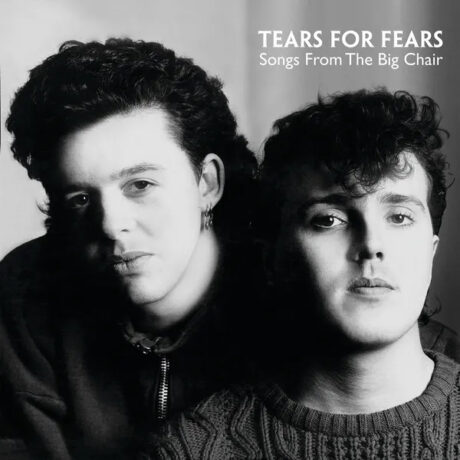
Tears for Fears captivated me the first time I heard the percussive opening beat of The Hurting in 1983. I wanted my hair to look like Smith’s did on the cover of Songs from the Big Chair, in 1985. I felt the first sparks of rebellion churn in my gut the first time I heard “Shout” and sang along. And I played “Woman in Chains” over and over until the CD player, (like the air conditioner and other luxuries in my 1985 Honda Prelude,) bid a final “goodnight.” There were few moments in my life as awkward and exhilarating as meeting Curt Smith at a Jars of Clay show at Mercury Lounge in NYC. Yea, I’m a fan.
Fortunately, my fears were misplaced. Tears For Fears’ new LP, The Tipping Point, is a beautifully contoured collection of songs that speak to the greater powers and principalities at work in the world and in us individually. It artfully confronts power dynamics, violence, and broader criticisms of government and religion with a reservoir of faith and respect for the mystery of the human life baked into its DNA.
The album opens with, “No Small Thing,” a Lumineers-esque prologue with a lyric that establishes the rules for the musical journey ahead. Lines such as “We punish the child for flying too high, for rushing like the wind” are prophetic with the assertion that freedom is best left untamed and recklessly wild. The duo seems to be letting us know that we listeners would do well to let go of our expectations, and anything else we may be grasping too tightly, and simply float along with them. After a closing, chaotic, crescendo that hearkens to The Beatles’ “A Day in the Life,” the album’s true opener beckons us farther into the depths. Track two, which also serves as the title track, makes one wonder if there were fights in the studio over the song sequencing. The expansive and anthemic sound of “The Tipping Point” offers a familiar rhythmic nod that will reward all of us who have maintained our air drumming skills from 1985.
The song “The Tipping Point” demonstrates the masterful way Tears for Fears can craft expansive, arena-filling orchestration without ever lapsing into melodramatic gimmicks or overstated sentimentality. At the risk of sounding like a curmudgeon, there are many young bands swimming in pools of retro sounds from the 1980s but lacking the musicality of that era. As a guy whose first band was made up of 4 synthesizer players, hearing the nostalgic digital timbres masterfully layered here reminds me that today’s Indie Rock scene too often settles for bands who use retro synths for sounds and not as instruments. Welcome back the OGs.
The song’s lyric draws heavily upon Orzabal’s experience watching his first wife, Caroline, succumb to the mortal effects of alcoholism and its associated maladies. If the truest litmus test of a songwriter’s maturation is how descriptive the confessional is expressed, Orzabal has clearly earned his 10,000 hours. It is clear from the beginning that this album is not merely a victory lap for nostalgia’s sake.
The third song, “Long, Long, Long Time,” is the first of Curt Smith’s contributions. His songs have historically been more complex in their melodic movement and accompaniment than Orzabal’s. The track also showcases the angelic vocals of Carina Round (Puscifer, Twilight Singers.) With her voice given top billing on the chorus, she delivers the thesis line perfectly. “Funny how the heart of everyone is the part you’ll never know…. Funny how the heart of holding on…. is letting go.”
Another Smith song follows. “Break The Man” takes on the patriarchy as only a man with a daughter can. “This is why someone was meant to say, enough is enough,” he implores. It seems remarkable that a song can use the lyric, “She’s the devil you understand,” with the sentiment of “Isn’t She Lovely?”
If the album has an outlier, a song that somehow doesn’t seem congruent with the others, it is the darkly pulsing, lyrically rhythmic, and menacing, “My Demons.” It’s a welcomed shift that complements the lightness of “Break the Man” with the eerie reminder that the balloon is still controlled by an evil clown lurking in the sewer.
When Jars of Clay sets out to make albums, we know we are on the right path when we discover the collection’s emotional anchor. For an album to really feel complete – with any hope of becoming a classic – there needs to be a song that feels like a true exhale. It must move me emotionally, mentally, and melodically. To my ears, “Rivers of Mercy” is that song here. It reminds me of the way a pause often appears during a lovers’ quarrel. The other songs mount arguments, fortify defenses, and articulate concerns, while this one flows like a thoughtful sigh at the album’s midpoint, suggesting the graceful sanity that besets us as we recognize and own our contribution to the challenges in our relationships. With a breath, we remember that love is resilient. We just need that pause.
While there are sonic references to earlier Tears for Fears songs throughout the album, “Rivers…” is the most unapologetically connected to their decades of beauty and finesse. This is where the record reaches the pinnacle of its beauty. This is where the album exposes its vulnerability. This is the soul of The Tipping Point. The song with the least number of words has the most to say. (“If by magic, you mean the ocean… If by tragic, you mean the end.”) The confession of pain is always the act that knits us together. The confession of need is equally as potent. And then a familiar modality steps forward in the form of a shimmering guitar arpeggio drawn from an old tributary called, “Woman in Chains.” Knowing the pain Orzabal felt watching his wife deteriorate in the grip of addiction, it is fitting that a song about recognizing powerlessness and letting go would sonically connect with the concept of violence and control over women. It’s a reach, but one that was not lost on me.
The advent of streaming renders the art of sequencing an album – putting the songs in a particular listening order – more difficult, and possibly pointless, than ever. Most artists have given up and simply frontload an album with the singles and then let the deeper album tracks languish in the doldrums of our short attention spans. So, it seems like an act of rebellion that this album would become more substantive, beautiful, and meaningful throughout its second half.
“Please Be Happy,” opens a gray window on the painful experience of watching a loved one struggle with depression. (“But these days it’s like a wave is breaking over you, drowning you in the undertow.” The thread of hope keeping the whole thing from falling to pieces is thinning and threatened, but by the end of the lushly orchestrated ballad, when Orzabal sings “I still believe this love can grow,” it feels like a prayer. There are shades of Simon and Garfunkel’s “Bridge Over Troubled Water” hovering over the darkness, connecting with the words of encouragement and supplication. I may be embellishing here – or reading into things – but that’s how it landed for me.
“Master Plan” sonically channels the Beatles influence that typified Sowing the Seeds of Love, with a lyric that reads as if it had been transcribed from a session in a dank church basement recovery meeting. “I feel rage,” Orzabal confesses. “I need faith / If my soul be damned / it’s all part of the master plan.” It flows like a musical serenity prayer. Artists make choices about the transparency of their words. Only the most courageous lean into opacity to artfully lift the fog on things like depression, addiction, loss, codependence, violence, and mental health.
Rounding the outer edge of the fulcrum is a song that feels hopefully resolute. “End of Night” takes all the dark and painful searching from the albums’ first side and wraps it up like a struggling and fighting animal caught in a net. It finally realizes that stillness is the only way out. Musically, the pop skin lightens the mood and pulls us a little farther from the edge of the abyss. This has long been a hallmark of Tears for Fears’ work, the ability to balance a heavy lyric with light pop elevation. “End of Night” seems to represent that point in our musical journey when the tension starts to resolve. We survived the trauma of the night, and the dawn is beginning to break like a Peter Jackson false ending.
And like all eventful and chaotic journeys, we attempt to find meaning in the experience. We wonder if it was worth the pain, the struggle, and the loss. The album’s epilogue, “Stay” does not provide a cheap answer to a valuable question. It speaks to the back and forth of the human condition. With an ecclesiastical spirit, it bounces between intimacy and disconnection, perhaps speaking to the reality that we never fully rid ourselves of the tension. What determines the tipping point of our decision to live, fully stepping into the suffering of others or choosing to abandon ourselves and the world? “Stay” may be the riddle that leads to the only benediction for which we can hope.
The Tipping Point will make my top 5 list for 2022. It won’t be the most innovative, most provocative, or most musically astonishing album of the year. It is, however, the most balanced, sincere, and soulful album I have heard this year. It is a remarkable offering that keeps Tears for Fears firmly ensconced as one of pop music’s greatest acts.
What is the antidote to artists aging badly? Beautifully telling the truth.
(Check out our conversation with Dan Haseltine on the True Tunes Podcast HERE!)
